Two years Abrdn Property Income Trust (formerly the Standard Life Property and Income Trust) bought 1400 hectares of land from the Ralia and Drumochter Estate with the stated intention of using the land to offset carbon emissions by planting trees. Abrdn were advised on the purchase and the “habitat restoration project” (see here) by Fenwick Drysdale of Akre/Kilrie Trees, whose family has connections with the Ralia Estate (see here) and who has stated his company will grow the trees at their nursery in Fife and then plant them out at Far Ralia. This week Scottish Forestry confirmed by email “that this scheme has now been approved with contracts issued” although this does not yet appear to have been recorded on the Woodland Grants Register.
While the details of what was approved are not yet known, I was pleased to be consulted by Scottish Forestry on the plans in May. Those plans in my view bear a significant resemblance to the native woodland plantation creation undertaken by Akre/Kilrie Trees at Leckie (see here) and, unless they have been significantly changed, are likely to be very damaging to the natural environment, as I stated in my response to Scottish Forestry (see here). They are also, as this post will demonstrate, a complete waste of public money and, while the exact amount awarded to Abrdn is not yet known, a Freedom of Information request has revealed a sum of c£2.23m was being considered.
The legacy of sporting mismanagement at Far Ralia
Far Ralia has in the past been used for deer stalking and grouse shooting. While Akre still claims on their website that the “land was not used for rural sporting pursuits or farming for decades”, the Woodland Grant Application stated “Sporting activities ceased in 2020”. There is no recent evidence of muirburn on the ground and it is likely intensive grouse moor management ended some time before that.
One might have expected that the cessation of stalking would have increased grazing pressure on the land, cancelling out any benefits from the end of muirburn, but in fact the opposite has happened:
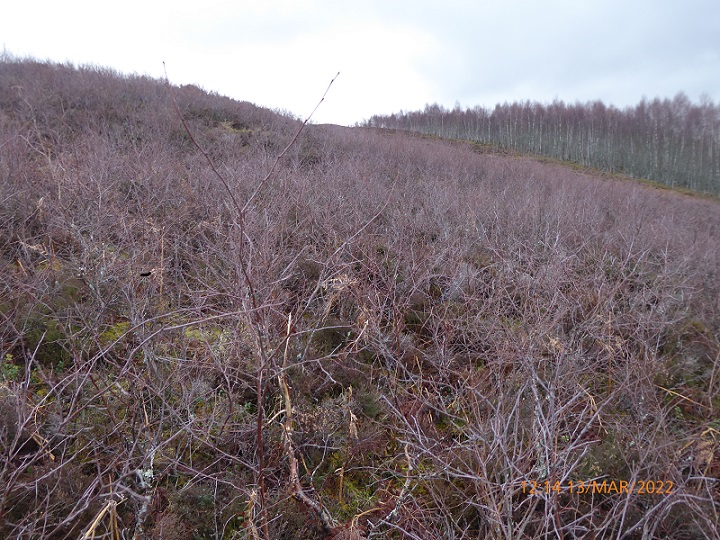
Dense natural regeneration of native woodland is evident in the western corner of Ralia next door to an obvious seed source.
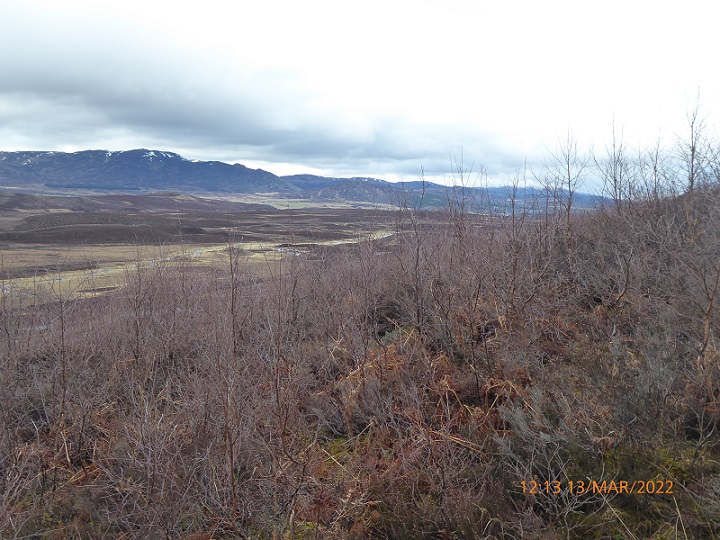
This puzzled me when I visited Far Ralia in March 2022. Why had natural regeneration taken off at the same time as deer management ended? My initial thoughts were that there must be some local reason why deer were no longer grazing this area of land, although I did note how birch were moving up the hillside and colonising new areas:
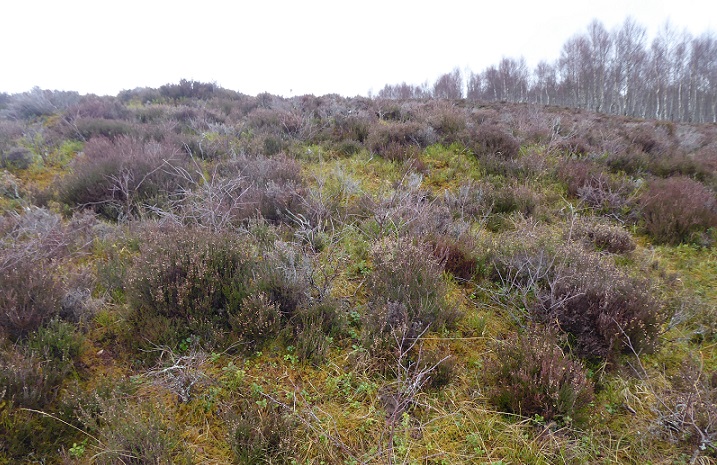
However, when I returned to Far Ralia earlier this week, I realised that this area of natural regeneration was far more extensive than I had originally thought. Seedlings are much easier to see when in leaf and there were birch and other trees on the disturbed ground by the track all the way up to the woodland enclosures near the centre of the estate:

Not only that but there was extensive regeneration of alder along the banks of the Allt Ghuibhais (the name tells you something about the natural history – “burn of the pines”).
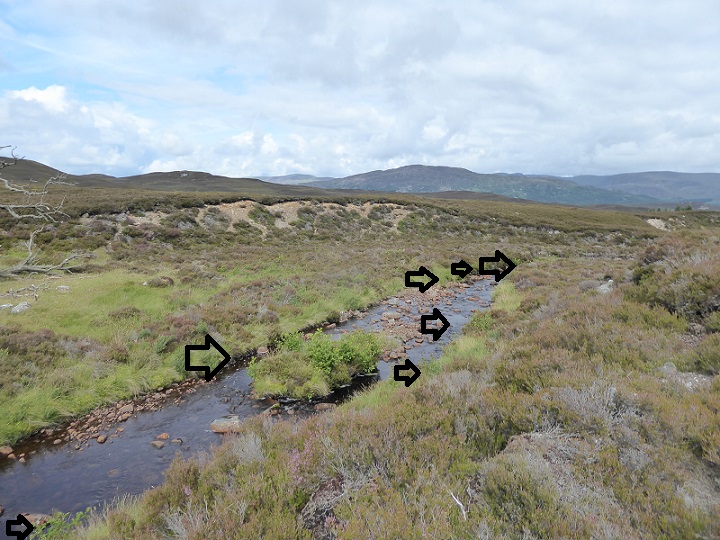
What this shows is that deer numbers must have reduced dramatically on the estate despite the lack of stalking activity by its owners. The explanation for this lies in what has been happening over the watershed and across the boundary of the estate in Glen Tromie, on land which is owned by Wildland Ltd. There they have reduced deer numbers to c2 per square kilometre and in the course of doing so appear to have culled many of the deer that would have moved between Glen Tromie and Far Ralia. That is confirmed by this statement in the Woodland Grant application:

This confirms that deer numbers have reduced and that the cause of this and the consequent natural regeneration of woodland lies in the responsible way Wildland Ltd has been managing their land.
Abrdn – profiting from deer management by others
The initial concept plans for Far Ralia were produced by SAC Consulting, who appear to be working in partnership with Akre, in February 2022. These proposed planting the western corner of Far Ralia, where natural regeneration is so prolific, with Scots Pine and constructing a deer fence along the extensive boundary with Wildland Ltd. Madness but that is what happens when forestry consultants earn their living through chasing grants and don’t bother to understand what is going on on the ground!
After this was drawn to the attention of SAC Consulting, the revised plans issued for public consultation this May included natural regeneration areas (shaded in purple):

The purple comes to a total of “47.00ha Natural Regeneration (NR), grant model”. It will be interesting to see if Scottish Forestry has awarded Abrdn grant funding for something that is already happening due to the actions of Wildland Ltd. If Abrdn had any decency they would send any grant they are awarded for this over the watershed!
While Abrdn’s application referred to a Deer Management Plan, none was included in the consultation documents and it is unclear what commitments they have made to control deer numbers in future. The fact that the application included the cost of a new expensive deer fence to sit alongside the existing one which runs along the northern half of the boundary with the Phoines Estate suggests not very much (a new fence has already been erected along the southern part of the boundary)..
While Abrdn/SAC/Akre can trust Wildland Ltd to keep deer numbers down, they clearly don’t trust Phoines to do the same and would prefer to get a grant for a fence than employ a local person as a stalker.
Payments for natural regeneration v payments for planting trees
While Abrdn should receive some grant money for the natural regeneration areas, Akre as tree planters are unlikely benefit. As a result while some areas in the grant application were earmarked for natural regeneration, these appear to have been kept as small as possible and for areas where the natural regeneration is impossible to ignore.
The plans indicate that everywhere else that is not deep peat (over 50cm) or high ground will be planted as intensively as possible in order to maximise the amount of grant: “Open Ground has been minimised due to the presence of so much deep peat and other non-grantaidable ground”.
The issue, as my photo above of the regenerating birch along the track in an area earmarked for Scots pine planting shows, is that natural regeneration has taken off over a far wider area than that marked on the map. If woodland is the desired objective, there is little or no need to plant trees as long as grazing pressure is reduced. The question is why Scottish Forestry continues to ignore the evidence from the end of the last ice age that woodland expanded at a rate of c100m a year?. If deer numbers were kept down and nature was left to take it course, a large chunk of Far Ralia would be covered in trees in ten years time.
Instead of allowing that to happen, Scottish Forestry has been considering whether to pay out £2.23m in grant that will benefit a company with family connections to the Ralia Estate, whose sporting estate management was responsible for the lack of trees in the first place, and to Abrdn Property Income Trust, a company based in the tax haven of Guernsey. This illustrates how the Woodland Grant Scheme is rotten to the core.
The destructive impacts of planting on soils
In my post on Leckie I explained how “mounding” on undisturbed releases considerable quantities of carbon into the atmosphere and cited research which shows that 39 years after planting trees will have not re-absorbed that carbon back from the atmosphere. This is an issue that should be at the front of the minds of everyone in Scotland who is truly concerned about how to tackle global warming
Akre/KilrieTrees used “hinged mounding” at Leckie, the most destructive form of mounding, but at Far Ralia only proposed to use this technique to plant trees in the wettest areas. Instead their plans proposed to use mainly “inverted mounding”, a technique where a digger scoops out turf and vegetation and returns it upside down in the hole and the tree is then planted on top of this.
Unlike at Leckie, however, most of the ground at Far Ralia is covered by peat which stores far more carbon than any other soil. As a consequence the amount of carbon released by planting trees on inverted mounds on peat will be far greater than in the podzols considered by the research.
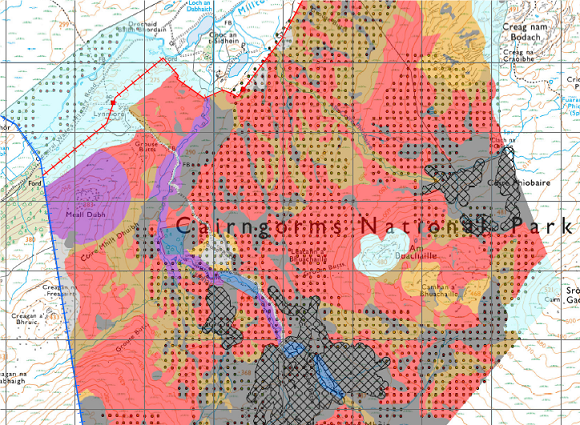
 Even at full scale, I could not make sense of this key. The red dots depict areas of peat over 50cm, on which planting trees is now not allowed according to Scottish Government policy, but there are many such dotes outside the grey areas, particularly in the red areas where it is proposed to plant Scots pine. The key shows the yellow dots depict peat 35-45cm deep, presumably an error which should have read “35-50cm” just as the dark green should have read “0-35cm” not “5-30cm”.
Even at full scale, I could not make sense of this key. The red dots depict areas of peat over 50cm, on which planting trees is now not allowed according to Scottish Government policy, but there are many such dotes outside the grey areas, particularly in the red areas where it is proposed to plant Scots pine. The key shows the yellow dots depict peat 35-45cm deep, presumably an error which should have read “35-50cm” just as the dark green should have read “0-35cm” not “5-30cm”.
One wonders if Scottish Forestry, even if they were minded to do so, would be able to calculate the likely carbon emissions that will be caused by Abrdn’s planting proposals from this data? Whatever the details, we can be fairly certain that this tree planting will add to global climate emissions for many years and do nothing to offset all the carbon that is being released through Abrdn’s massive investments in fossil fuels (see here) .
Wider carbon and environmental considerations of planting trees at Far Ralia
Instead of letting nature to do it for free, growing trees in nurseries and then planting them out has considerable environmental costs whatever the truth of Akre/Kilrie Trees claims to be “the first verified carbon negative tree nursery”.
In the case of Far Ralia the carbon emissions that need to be taken into account include:
- the carbon costs of travel to collect seed from the site (seed that could have sown itself naturally!);
- the carbon costs of returning the saplings to the site
- the carbon costs of “upgrading” the access road to enable diggers to access the site (see here but more soon!)
- the carbon cost of excavating c500,000 mounds, inverted and hinged
- the carbon cost of the new fencing
- the carbon cost of the “Approximately 556,500 vole guards will be required”. The Woodland Grant application did not state if these were plastic or not but if plastic that is yet more fossil carbon that will be consumed by this project.
I saw no signs of voles nibbling on the stems of the naturally regenerating trees at Far Ralia but then they are doing so gradually and the predators on site – we saw both short-eared owl and hen harrier – appear sufficient to keep those numbers under control. Plant 500,000 nursery grown trees close together in one season, however, and the population of voles and hares will inevitably explode. It is not just the amount of extra food that is available over the winter which causes the problem, but the fact that trees grown in nurseries are far richer in nutrients than those that regenerate naturally. Nursery grown trees provide a right feast, hence the vole guards.
While trees do form even aged stands naturally they do so in far smaller areas than what is proposed for Far Ralia. This, as I showed in my post in Leckie, will be little different to any standard even-aged sitka plantation but with native species. If we want to enable woodland which is good for nature to develop, it needs to have a varied age structure. Another policy idiocy is that while Forest and Land Scotland is trying to vary the age structure and diversify its conifer forests around places like Aberfoyle, Scottish Forestry is aiding and abetting landowners to re-create monocultures but this time with native trees!
On top of this, most of the planting proposed in the Woodland Grant application was for ten a penny Scots pine and birch with no willows, for example, included. That may be partly explained by the limited range of trees currently grown by Akre Trees:

Whatever the explanation, the diversity gains of the Far Ralia planting will therefore be limited (different species of tree support different species of insects etc) and will do little to reverse the reduction in biodiversity caused by sporting management as described in the Woodland Grant application:
“Due to the historical land use of deer stalking and driven grouse shoots (this included sheep grazing), the plant species diversity at Far Ralia has become low in diversity compared to semi-natural, or natural, upland scrub. (The costs and benefits of grouse moor management to biodiversity and aspects of the wider environment: a review, Murray C. Grant, John Mallord, Leigh Stephen & Patrick S. Thompson 2012). This lack of diversity is due to drainage, muir burning and heavy grazing.”
The lessons for the Scottish Government from Abrdn’s trash-it management
It is quite possible that Scottish Forestry may have amended some of the proposals that were put out for consultation in May and reduce the amount of grant requested from £2.23m. Some of the criticisms I have made of the scheme as presented in May could be addressed (one would hope, for example, that Scottish Forestry would at least insist on biodegradable vole guards and refuse to pay for a duplicate deer fence along the boundary with the Phoines Estate).
Unfortunately the woodland grants scheme consultation process is mainly conducted out of sight of the public unlike the planning system (you have to ask to see consultation documents), is far from transparent and responses from organisations like the Cairngorms National Park Authority not published as a matter of course. It is impossible to tell therefore how much pressure was put on Scottish Forestry to amend Abrdn’s disastrous proposals. It is likely the most damaging element, the use of inverted mounding to plant trees on peat less than 50cms deep will remain as that reflects the Scottish Government’s current policy position. Time and Freedom of Information requests will show what was actually granted and agreed.
Abrdn’s outline proposals for Far Ralia, however, provide an excellent demonstration of the incoherence of the Scottish Government’s current approach to carbon sequestration. As the map shows, on the one hand Abrdn is proposing to restore areas of damaged peat while just 30m away it proposes to turn chunks of vegetation and peat, 40cm x 40cm, upside down exposing the peat to the atmosphere where it will oxidise and release carbon. This is madness. And to rub salt into the wound under the current system the Scottish Government will be paying Abrdn and its agents to do both!
At this stage there is no indication of the amounts that might be paid out to Abrdn and its agents Akre for peatland restoration. Were the Cairngorms National Park Authority (who like Scottish Forestry are under pressure to spend the grants) pay out £500,000 on top of say £2,000,000 in woodland grants that would come to a total of £2.5m. Why on earth wold the Scottish Government be providing £2.5m in funding to one of the largest, most profitable and most polluting companies in Scotland when a large proportion of the population, including people living in Strathspey, are suffering enormously as their incomes are driven down?
It would be far better to have offered that £2.5m to local communities to buy part of Far Ralia and do nothing than to pay Abrdn and their agents to build a great new track through the landscape so they could expose peat and other soils to the atmosphere. Instead of helping local communities, the Scottish Government is allowing companies like Abrdn to buy up land for speculative purposes and then trash it, in the process of which they are inflating land prices beyond the reach of most of the population..
An email sent to Scottish Forestry in May 2021 (and released under FOI) suggests that from the very beginning Abrdn has shown more interest in maximising their profits and offsetting their costs than in offsetting carbon or restoring nature: “In terms of potential grant funding to offset some of the cost, could you please point me in the right direction”. Its outrageous but no-one in government appears outraged.
If the Scottish Government is serious about tackling climate change it needs to stop companies like Abrdn buying land for greenwashing purpose, while the sooner the Woodland Grant Scheme in its current form is scrapped the better.
Superb post – ought to be on the front page of the Guardian
As an investor in abrdn I will put some questions to them on their plans for Far Ralia.
This is another excellent article, keep them coming.
That would be great, I hope others do so and do let me know the answers!
An excellent expose of a byzantine and perverse system of land subsidy that for good measure takes from the ordinary taxpayer to give to the well off. All this at a time when lots of people are struggling. Also another example of when the principle pressure (over grazing) is taken off nature manages nature best.